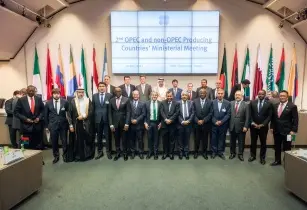OPEC and 11 non-OPEC oil producers, including Russia, have agreed to roll over production cuts for a further period of nine months, beginning 1 July 2017, in a bid to stabilise oil prices and reduce oil inventories
The decision was announced at their meeting in Vienna on 25 May.
The alliance of OPEC and non-OPEC producers reached a historic agreement to reduce production by 1.8 mn bpd last December, taking effect 1 January, since when the oil price has remained relatively stable at around the US$50/barrel mark.
“The goal of accelerating rebalancing has been partially achieved and the market in my opinion is on its way to full recovery. The drawdown of inventories has clearly begun and I expect this trend to accelerate as we enter the high demand season and continue our high conformity levels,” said Khaled Al-Falih, Saudi Arabia’s Energy Minister and President of the OPEC Conference, adding that more time was needed to bring inventories down to target levels.
At a press conference Al Falih said that the meeting had considered various scenarios to extend the arrangement by six, nine and twelve months as well as options for a higher cut, but that “all the indications are that a nine month extension is the optimum and should bring inventories to a five year average by the end of the year,” with the extension to March designed to avoid seasonal demand declines and stockbuild. The Joint Ministerial Monitoring Committee will continue to monitor conformity, evaluate market developments and recommend interventions and adjustments. Al-Falih remarked that a further extension to the agreement could be a possibility and “we will cross that bridge when we come to it.”
Libya and Nigeria will continue to be exempt from production cuts. “We are not going to be imposing limits on Libya or Nigeria any time soon,” Al-Falih commented.
OPEC and the participating non-OPEC countries also agreed to strengthen their cooperation “with a view to ensuring a sustainable oil market for the benefit of producers, consumers, the industry and the global economy,” according to a press statement.
While many commended the spirit of continuing co-operation between OPEC and non-OPEC countries, as well as the reported high levels of conformity, the oil price initially dipped by five per cent in the wake of the announcement, as many investors had hoped for deeper cuts. Prices recovered somewhat on Friday with Brent crude standing at US$51.77 on Friday morning.
Sam Wahab, director of oil & gas research at Cantor Fitzgerald Europe said, “There seems to be a little resistance on the price at US$55/bbl, but if OPEC members and a selection of non-OPEC members – notably Russia – abide by the supply cut, the price could conceivably hit US$60/bbl by year end.
“It is also worth noting that Saudi Arabia is in the process of listing Aramco (the national oil company), and will therefore require a stable oil price to support their US$2tn valuation of the company, and so it is in the country’s interest to continue with production cuts.
“The key risk to the downside continues to stem from growing US production, which threatens to replace the cut in supply from Saudi/Russia. A further eight US oil rigs were added last week, bringing the total count up to 720, the most since April 2015, and it is very likely this trend will continue at current oil prices. US output has increased by around one million bpd to 9m bopd, placing the country’s output alongside Saudi Arabia and Russia, thus somewhat diluting OPEC's ability to play a role in setting prices and supplies.”




